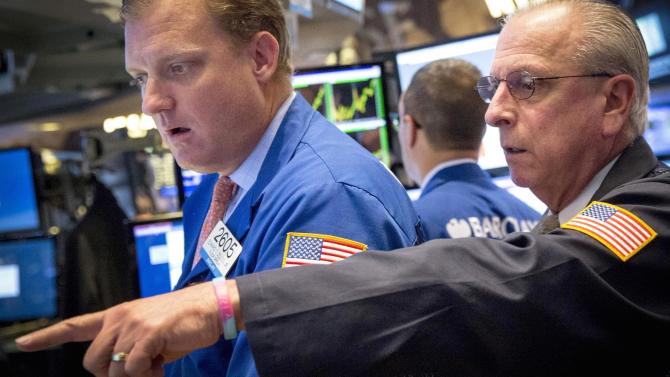Dow drops 200 points, S&P falls 1% as China weighs; oil drops 4%
August 19, 2015
U.S. stocks traded sharply lower on Wednesday after a wild trading session in China sent other Asian markets down and as Wall Street awaited the release of the Federal Reserve’s July meeting minutes. (Tweet This)
“You’re seeing a spillover from overseas markets into our markets,” said Mark Luschini, chief investment strategist at Janney Montgomery Scott.
The Dow Jones opened Wednesday trading by shedding over 150 points before falling over 200 points in late-morning trading, while the S&P 500 and the Nasdaq Composite both fell 1 percent.
China’s Shanghai Composite closed 1.24 percent higher overnight after falling over 4 percent at its session lows. This wide trading range sent Japan’s Nikkei 225 down 1.61 percent and the Hang Seng index down 1.31 percent as concerns over China’s economic stability grew once more.
Meanwhile, European equities traded about 1 percent lower after Germany’s lawmakers approved Greece’s latest bailout program, all while investors waited the latest Fed meeting minutes.
“The focus of the day is going to be the Fed,” said Peter Cardillo, chief market economist at Rockwell Global Capital. “I think the market’s going to get relief from the fact that the Fed is resolved to hike in September.”
“A Fed rate hike of 0.25 percent wouldn’t be a bad thing,” said William Lynch, director of investments at Hinsdale Associates. “It would get the uncertainty out of the way.”
Read More Don’t expect Fed to signal rate hike: Strategist
A Fed rate hike this year would be the first one in about a decade, but Nick Raich, CEO at The Earnings Scout, said the central bank may have a harder time lifting off than it previously thought.
“In the first quarter [of 2015], the Fed itself said the global growth slowdown was due mostly to transitory factors,” Raich said. “There is a global growth slowdown and the Fed will have to take that into consideration as it prepares to set monetary policy next month.”
This slowdown is shown especially within the commodities complex, particularly in oil, Raich added.
U.S. oil (New York Mercantile Exchange: @CL.1) prices dropped about 4 percent in late morning trade, pushing energy stocks down about 3 percent, after the Energy Information Administration reported an unexpected rise in crude stockpiles.
“Oil has been bouncing around this $41-$42 range and that could put some pressure on markets, but it’s all about the Fed,” Cardillo added.
“I think that’s putting pressure on energy stocks. That being said, this is a broad-based selloff,” said JJ Kinahan, chief strategist at TD Ameritrade.
Kinahan added that the combination of the volatility overseas and not knowing what’s in the Fed minutes has led to many investors to find safe haven in the VIX, as it’s more of an “in-and-out trade” than Treasurys, for example.
The CBOE Volatility Index (VIX) (^VIX), widely considered the best gauge of fear in the market, traded near 15, up over 12 percent on the day.
Wall Street also weighed the latest reading from the Consumer Price Index, which rose 0.1 percent in July versus the expected 0.2 percent increase, the Labor Department said.
The department added that core CPI also rose 0.1 percent.
“Bottom line, differentiating between commodity deflation and services inflation and we have the tale of two price stories,” said Peter Boockvar, chief market analyst at The Lindsey Group.
“As the Fed tells us that they think the PCE is a better gauge of prices, the 1.8% core CPI y/o/y rate, matching the most in a year, does not match the measure of price stability (aka, 2% core inflation) that they are so focused on achieving. What this figure today tells us about the outcome of the September FOMC meeting is very little only because they have chosen the PCE as their preferred inflation measure.”
Read More Street picks: 10 housing stocks ready to pop
Investors also took in a slew of news, as Lowe’s (LOW) reported earnings per share that missed expectations, but its revenue and same-store sales came in above forecasts. The company’s full-year guidance also came in better than expected.
Staples (SPLS) also reported earnings per share of 12 cent, matching estimates, on revenue that was essentially in line with expectations, while Hormel Foods beat earnings per share estimates, but came in light on revenue.
Furniture make La-Z-Boy (LZB) posted earnings per share of 27 cent a share, beating expectations, while same-store sales rose 5.3 percent.
Analog Devices (ADI) reported 77 cents earnings per share for last quarter, beating estimates, while revenue also came in better than expected.
Target also posted better-than-expected earnings, beating earnings per share estimates by 11 cents, sending the stock up over 4 percent.
L Brands, NetApp and Popeyes Louisiana Kitchen are all scheduled to report after the bell.
The Dow Jones Industrial Average (Dow Jones Global Indexes: .DJI) traded down 217 points, or 1.2 percent, at 17,294 led lower by Chevron.
The S&P 500 (^GSPC) traded down 24 points, or 1.2 percent, at 2,072, as energy led all sectors lower.
The Nasdaq (^IXIC) fell 58 points, or 1.1 percent, to 5,000 as the iShares Nasdaq Biotechnology ETF dropped about 1 percent.
U.S. 10-year Treasury note yields traded lower at about 2.17 percent.
Gold futures rose $10.80 to $1,127.50 an ounce by 11:40 a.m.
Decliners led advancers 5 to 1 at the New York Stock Exchange, with an exchange volume of 190 million and a composite volume of 793 million by 10:49 a.m.
On tap this week:
Wednesday
Earnings: L Brands, NetApp, Synopsys
2:00 p.m.: FOMC minutes
Thursday
Earnings: Gap, Hewlett-Packard, Salesforce.com, Brocade, Mentor Graphics, Royal Ahold, Buckle, Madison Square Garden, Toro, Intuit
8:30 a.m.: Initial claims
10:00 a.m.: Existing home sales
10:00 a.m.: Philadelphia Fed survey
Friday
Earnings: Deere, Foot Locker, Ann
More From CNBC.com:
- Millennials who shook the world
- Ashley Madison probes veracity of data leak
- Carlsberg shares tank 7%, hit in key Russia market
-CNBC’s Peter Schacknow and Reuters contributed to this report.
Search
RECENT PRESS RELEASES
Related Post





